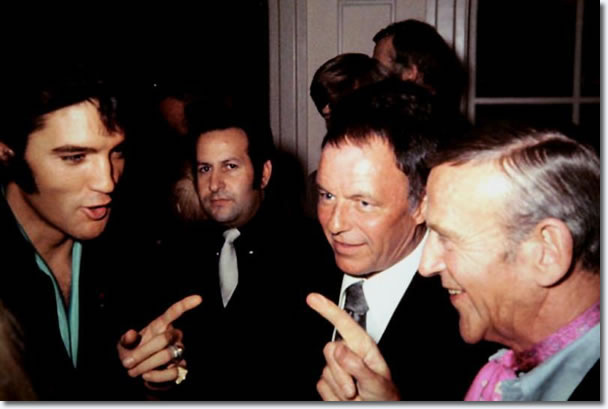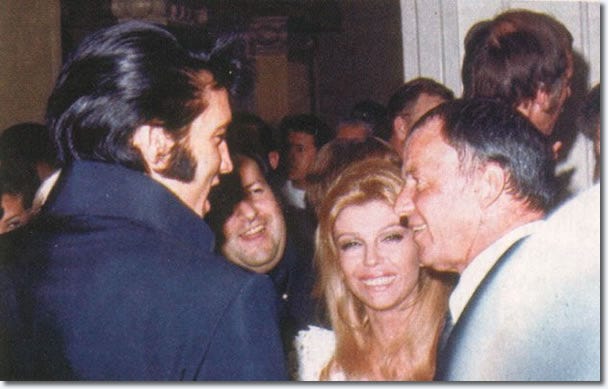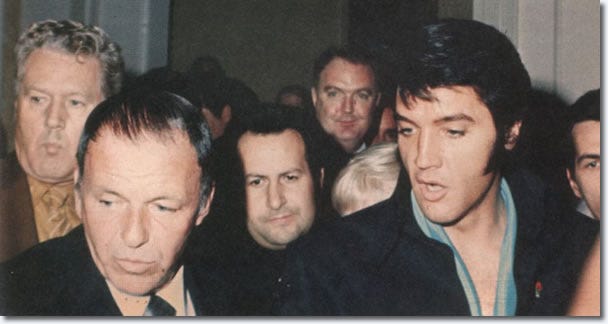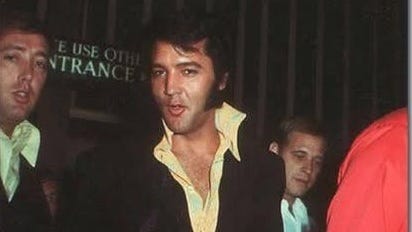Sinatra Meets Elvis!
A Presley Anniversary Special
First off, I want to thank Sinatra scholars Scott Henderson and Ed O’Brien, who run a very highly detailed mailing list, for sharing these photos and other tidbits and for reminding me that Saturday, August 16, marked the 48th anniversary of Elvis Presley’s tragically early death. I wanted to recap and consolidate some of the known facts about the relationship of Sinatra and Elvis, and also throw in a new anecdote that I don’t believe has ever been in print before.

1957 / 2010
The first time Sinatra and Elvis crossed paths—at least intellectually—came in the fall of 1957, when Sinatra made his infamously dismissive and derisive comments about the burgeoning popularity of what was then just starting to be called “Rock ‘n’ roll.” I won’t quote from them here - this verbiage, unfortunately, is easily searchable on the world wide interwebs.
However, I’ll recount a personal anecdote: these quotes (“cretinous goons,” etc.) appear in virtually every history of pop music, as well as every biography of either Sinatra or Presley, but virtually no one offers an accurate source. Around 2010, when Jim Kaplan was in the middle of researching the second volume of his epic Sinatra bio, The Chairman, he called me, and pointed this out to me. He couldn’t ascertain the provenance of the quote either. So we did a deep dive, and, it must be admitted, the methods for web searching and internet-driven research were not nearly as sophisticated as they are in 2025 - the year of Sinatra’s 110th and Elvis’s 90th birthdays.
It is a rare occasion when two researchers are looking for something that they are hoping not to find. We were both hoping that the quotes weren’t real, that someone somehow attributed them to Sinatra, or put words in his mouth. If we couldn’t find the original source, then maybe they were not actual quotes from him, and maybe he never made those embarrassing, short-sighted comments which, as they invariably do, reflect more negatively on Sinatra himself than on Presley.
Well, we were wrong, sort of. Jim found the source; it was an article that appeared under Sinatra’s byline in a French publication called Western World. More recently, Alan Hanson, a highly-respected Elvis scholar, combed through all the source material, including the excerpts from the French magazine that were translated into English for American newspapers. Hanson concluded that though Sinatra was angrily dumping on rock music and those who listen to it, there was nothing in the original French story that could be construed as a specific attack against Elvis himself. However, in the U.S.A., the sensationalist, semi-yellow press tried to provoke a kind of battle of the superstars by making it look like Sinatra was, sour-grapes style, belittling Elvis.
Presley himself took the high road and defended his music and his fans, saying that he admired Sinatra “as a performer and an actor” but that “I think he’s badly mistaken in this.” (Related facts: Presley was a Frank fan to the extent that he christened his entourage “The Memphis Mafia,” and he would record roughly 11 songs either in Italian or adapted from an Italian source - which is many more than Sinatra.)
1960:
When it was known that Elvis Presley was returning from the army in the spring of 1960, his manager Colonel Tom Parker essentially held an auction amongst TV networks and variety show hosts and producers: all the major shows had an equal opportunity to bid: Ed Sullivan, Steve Allen, Perry Como, Dinah Shore, Garry Moore, etc. At this time, a fair rate for a guest shot on a major variety show was about $15,000. The bidding on Elvis’s return appearance went all the way up to $125,000 for two solo songs and a duet with the host - roughly ten minutes of screen time.
Sinatra, who was then in the midst of producing and starring in four specials over two seasons sponsored by the Timex watch corporation, prompted Timex to pony up the $125K for Elvis and the Colonel. As part of the deal, Nancy Sinatra, who was then 19 and had been an Elvis fan from the beginning, was to be the first person to greet Elvis when he returned home from his stint in the army, stationed in Germany, in March of 1960.
The resulting special, Welcome Home Elvis, has become a classic. Elvis gets two solos; “Fame and Fortune” is a memorable rock-driven cautionary tale, certainly an under-rated Elvis ballad. I’ve never thought of the second song, “Stuck on You,” as top-tier Presley, but it’s sufficient, and gives Elvis the chance to exhibit his vocal and physical mannerisms. As I’ve said in these pages, if only Sinatra and Timex had waited just a few weeks later to produce and air this special, they would have been able to capture Presley doing one of his biggest hits and masterpieces, his take on the 1926 “Are You Lonesome Tonight,” truly a great moment in music.
Still, the Elvis / Sinatra duet, a mash-up of a Nelson Riddle-ized “Love Me Tender” and a countrified “Witchcraft” (I knew Cy Coleman; I can only imagine that he was delighted) has become iconic, as much a meeting of inter-generational legends as the Judy Garland - Barbra Streisand duet medley of 1963.
Suffice it to say, “Welcome Home, Elvis” was a ratings blockbuster, and the $125K forked over by Timex to Colonel Tom turned out to be a bargain. (By the way, Peter Guralnick’s new biography of the Colonel is nothing less than a must-read—and challenges virtually everything we thought we knew about Colonel Thomas Andrew Parker, nee Andreas Cornelis van Kuijk.)
Below, here’s the Elvis segment complete:
1970:
At the end of the 1960s, Sinatra and Elvis were essentially a two-headed juggernaut that was changing attitudes towards pop music. Up until now, solo concerts by popular singers and bands, even Olympian headliners like Sinatra and Presley, were relatively rare. The Beatles, as far as I know, only performed in package-style tours and never did anything like a “solo” concert in the U.S.A. Evenings like Judy Garland, Harry Belafonte, and Tony Bennett at Carnegie Hall were exceptions and not the rule. Sinatra himself had never done a solo show at Carnegie. But by 1970, Presley had begun showing the world that tens of thousands of folks would pay top ticket prices to see an Elvis or a Sinatra in stadiums so large that they had previously only been utilized for sporting events. (If only the Beatles had stayed together, their fortunes would have been much enriched if they had decided to tour again, this time through American stadiums and Vegas-sized mega-showrooms.)
There’s more to say about the interaction of Sinatra and Presley in the latter few years of the rock king’s life. But I wanted to conclude with an anecdote related to me by the late songwriter—and very dear friend—Ervin Drake. Drake (1919-2015) had essentially started his career with the jazz standard “Good Morning, Heartache” and then climaxed it with “It Was a Very Good Year,” originally composed in 1961 but recorded definitively by Sinatra in 1965. There were numerous hits and standards in between: “Tico Tico,” “Perdido,” “I Believe,” “The Father of Girls,” “A Room Without Windows” and the rest of the score to the Broadway musical What Makes Sammy Run After “A Very Good Year” became a signature song for Sinatra, the two men became close friends. In his eighties, Ervin told me the following tale.
It’s about 1970. Both Sinatra and Elvis are headlining at different big rooms in Las Vegas. Sinatra invites Ervin to make the journey from Great Neck, Long Island to Vegas to hear his song live. After the concert, Sinatra and Ervin are hanging out by the pool, glasses of Jack Daniels in hand. They are talking about one thing or another, when the subject of Elvis raises its pompadoured head.
Sinatra says, “I think Elvis is great. I don’t understand why. I don’t understand that music at all, but Elvis is great.”
Ervin says, “I don’t understand it at all either, but I agree with you. Elvis is the greatest. I don’t know exactly what it is that he does, but there’s no one who does it better than Elvis.”
Sinatra: “That’s a good way to put it. Whatever it is, Elvis is the best at it!”
At this point, the two men clink their glasses together in a toast, and move on to other topics.
Next week — more swinging nursery rhymes — The sequel song, “I Found My Yellow Basket” (there actually were at least three other big band versions in addition to Fitzgerald and Webb) and “Mutiny in the Nursery.”
(Very special thanks to Elizabeth Zimmer & Dan Fortune for their expert proofing, hey!)
Sing! Sing! Sing! : My tagline is, “Celebrating the great jazz - and jazz-adjacent - singers, as well as the composers, lyricists, arrangers, soloists, and sidemen, who help to make them great.”
A production of KSDS heard Saturdays at 10:00 AM Pacific; 1:00 PM Eastern.
To listen to KSDS via the internet (current and recent shows are available for streaming) click here. Here is the running list of recent shows.
The whole series is also listenable on Podbean.com; click here.
SING! SING! SING!
A-Tisket A-Tasket - Swinging Nursery Rhymes!
(SSS #161 2025-08-16)
download: <or> play online: + Playlist:
Tony Bennett @ 99! 70 Years of Great Moments LIVE ! (1947-2016) (SSS #159 2025-08-02 )
download: <or> play online: + Playlist:
Frank Loesser & Burton Lane
(SSS #158A 2025-07-26)
download: <or> play online: + Playlist
Frank Loesser & Hoagy Carmichael
(SSS #158B 2025-07-26)
download: <or> play online: + Playlist
Frank Loesser & Jimmy McHugh
(SSS #158C 2025-07-26)
download: <or> play online: + Playlist
The Oscar Peterson Centennial - Oscar Meets the Swinging Singers!
(SSS #157 2025-07-19)
download: <or> play online: + Playlist:
ALAN BERGMAN at 97: A Birthday Present!
(SSS #011 2022-09-10)
download: <or> play online:
Bastille Day - Cole Porter in Paris
(SSS #156 2025-07-12)
download: <or> play online + Playlist
July 4 Special: Every State in the 48 is Great
(SSS #155 2025-07-05)
download: <or> play online:
With Seth McFarlane: “Lush Life: The Lost Sinatra Arrangements”
(SSS #154 2025-06-28)
download: <or> play online:
SLOUCHING TOWARDS BIRDLAND is a Substack newsletter by Will Friedwald. The best way to support my work is with a paid subscription, for which I am asking either $5 a month or $50 per year. Thank you for considering. (Thanks as always to Arlen Schumer for special graphics.) Word up, peace out, go forth and sin no more! (And always remember: “A man is born, but he’s no good no how, without a song.”)
Note to friends: a lot of you respond to my Substack posts here directly to me via eMail. It’s actually a lot more beneficial to me if you go to the Substack web page and put your responses down as a “comment.” This helps me “drive traffic” and all that other social media stuff. If you look a tiny bit down from this text, you will see three buttons, one of which is “comment.” Just hit that one, hey. Thanks!j
Slouching Towards Birdland (Will Friedwald's Substack) is a reader-supported publication. To receive new posts and support my work, consider becoming a free or paid subscriber.





IIRC (and I often don't) Judy Garland did take her one woman show on the road-- I saw her do it at the Montreal Forum in the early '60s.
Just thought I'd pass along this fun fact gleaned from Peter Guralnick's great new bio of Colonel Parker: did you know that for years in Palm Springs at Christmas he would dress up as Santa Claus and visit Dolly Sinatra's home? So clever!